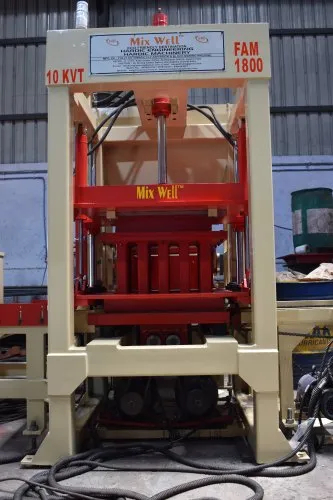
Cement Brick Making Machine
A Cement Brick Making Machine is a mechanical system that produces bricks using cement, sand, stone dust, water, and sometimes fly ash or slag. It compresses or vibrates the mixture into molds to form bricks with high compressive strength and uniformity.
These machines are extensively used in construction projects and are ideal for manufacturing solid, hollow, and interlocking cement bricks.
| Component | Material | Purpose |
|---|---|---|
| Main Frame | Structural body | |
| Hydraulic System | Cylinders, Valves, Power Pack | Provides pressing force |
| Electric Panel | Manual or PLC-Based | Controls operations |
| Vibration Motor | Industrial Electric Motor | Ensures compact bricks |
| Mould Set | EN8 Steel or Cast Iron | Shapes the bricks |
| Feeding System | Conveyor or Hopper | |
| Control Mechanism | PLC/Relay Timers | Manages timing, stroke, and pressure |
Design & CAD Modelling Bricks size & machine layout are digitally designed.
Fabrication Cutting and welding of steel for frame and body.
Machining Moulds, hydraulic parts, and gear systems are precision-machined.
Hydraulic Assembly Power pack, oil tank, hoses, and valves installed.
Electrical Setup Panel with relays, motor starters, and sensors.
Quality Testing Test run for performance, vibration, and output rate.
Raw Material Preparation: Cement, sand, and stone dust (or fly ash) are mixed in a pan or concrete mixer.
Feeding: The mixture is conveyed to the machines hopper.
Moulding: Material is transferred into moulds.
Compacting: Machine uses hydraulic compression and/or vibration to shape bricks.
Ejection: Finished bricks are pushed out and collected on pallets.
Curing: Bricks are left for 728 days in a shaded curing area for strength gain.
| Type | Operation | Capacity (Bricks/Day) |
|---|---|---|
| Manual | Hand-operated lever | 5001000 |
| Semi-Automatic | 20004000 | |
| Fully Automatic | Batching + pressing + stacking | 600025,000 |
| Mobile Brick Machine | Movable without pallets | 10003000 |
| Interlocking Brick Machine | For eco bricks |
Manufacturing:
Solid Cement Bricks
Hollow Cement Blocks
Interlocking Bricks
Construction Sites:
Boundary walls, compound walls
Apartment and office buildings
Industrial and warehouse projects
Reduces dependency on red clay bricks, thus preserving topsoil
Improves construction speed and consistency
Supports infrastructure development through scalable brick output
Facilitates automation in brick production, reducing human error
| Advantage | Description |
|---|---|
| High Strength | Compression strength up to 12 MPa |
| Eco-Friendly | No kiln needed; reduces pollution |
| Dimensional Accuracy | Saves mortar and plaster |
| Fast Production | Up to 25,000 bricks per day |
| Cost-Effective | Low labor, high yield, reuses waste |
| Customizable | Mold size and shape can be changed |
| User-Friendly | Semi and automatic models are easy to operate |
Construction companies
Infrastructure and PWD contractors
Cement block manufacturing units
Rural development and Gram Panchayat projects
Road and highway construction (for curb blocks)
A: The most common size is 230 mm Χ 110 mm Χ 75 mm, but machines can be customized.
A: Cement, stone dust, sand, water, and sometimes fly ash or slag.
A: Yes. They must be water-cured for 728 days for strength development.
A: A small semi-automatic unit requires 5001000 sq. ft.; full automatic units may need 30005000 sq. ft. including curing yard.
A: Yes. In India, MSME units, startup subsidies, and Mudra loans often support such machines.
With rising demand for eco-friendly and high-strength building materials, cement bricks have become a cornerstone of sustainable development. These machines promote automation, reduce labor dependency, and help meet construction targets faster while supporting green practices in the building sector.
Conclusion
The Cement Brick Making Machine is a critical investment for any modern builder or manufacturer looking to produce high-quality bricks at scale. It offers:
Consistency
Speed
Environmental sustainability
Cost efficiency
By replacing traditional clay bricks with cement bricks, industries reduce their ecological footprint while improving productivity and profit margins.
Office Address
C-1, 77/1, Kaka Estate, Ambicanagar Road, Nr. National Plastic, Odhav, Ahmedabad β 382415, Gujarat, India.
Factroy Address
24, Shreeji Estate Near Sankalp Estate, Bakrol Cir, Ahmedabad-382430, Gujarat, India
mixwellindia@gmail.com
hardicengineering@gmail.com
+91 99042 01922
+91 98984 74351
Also Send Mail
© Hardic Engineering . All Rights Reserved.
